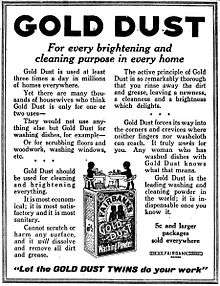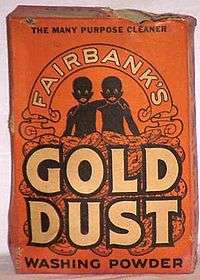Gold Dust washing powder
|
Early Gold Dust Washing Powder product box | |
| Product type | Laundry detergent |
|---|---|
| Owner | Unilever Corporation |
| Country | United States |
| Introduced | 1889 |
| Related brands | Gold Dust washing powder, Gold Dust scouring soap. |
| Markets | United States, Canada, and the United Kingdom. |
| Previous owners | N. K. Fairbank Corporation |
| Website | http://www.unilever.com/ |
Fairbank's Gold Dust washing products was a line of all-purpose cleaning agents researched and developed in the late 1880s by the N. K. Fairbank Soap Manufacturing Company.[1] First introduced to the American consumer in 1889, Gold Dust Washing Powder quickly became a success due in large part to its low selling price. The most easily recognized members of the soap line were Gold Dust Washing Powder and Gold Dust Scouring Soap. They were marketed in boxes and containers prominently featuring the brand's well known trademark, the Gold Dust Twins. The back of the box depicted the twins tackling several household chores and a list of jobs made easier by using Gold Dust Washing Powder. "Let the Twins Do Your Work" was the product's long lasting and ubiquitous slogan.
Background
The task of doing laundry had begun to change with the introduction of washing powders in the 1880s. Until that time, laundry was done using hard bar soap, washboards, and the repeated beating and wringing of the clothing items. The success of several of the new washing powders had proven that there was a ready market for what the consumer believed to be better and more economical cleaning agents. Most of these new products, however, were simply pulverized soap[2] and fell short of having any significant improvement in doing the laundry.
History

Introduced in 1889 by the Nathaniel Kellogg Fairbank Soap Company, Gold Dust washing powder was the first all purpose laundry powder made possible by employing hydrogenated vegetable oils in its processing, a procedure the company pioneered, and industry quickly embraced. The formula for Gold Dust Washing Powder had been refined by industrial chemist James Boyce working at the Chicago, Illinois,[3] facilities of the New York-based Fairbank Company.[4] Boyce's industrial hydrogenation procedure, when applied to cottonseed (and other plant materials), was a scientific breakthrough. This allowed for its subsequent use (by French chemist Paul Sabatier and manufacturing giant Procter & Gamble) in the commercial exploitation of vegetable oils and fats.
Initially a regional success in the Midwestern United States, Gold Dust Washing Powder quickly rose to national prominence after the brand was licensed for distribution in America by the Lever Brothers Company, headquartered at the time in Cambridge, Massachusetts. Lever brothers later purchased the Gold Dust brand in the 1930s.
The Gold Dust Twins
After 1892, the product's packaging—black and white graphics on a bright orange background—focused attention on the iconic Gold Dust Twins. The Gold Dust Twin characters of Goldie and Dustie were the 'faces' of Gold Dust products through most of their production, becoming one of the earliest brand-driven trademarks in American advertising. They were often comically depicted, along with a huge stack of dishes in a washtub, with one twin cleaning, the other drying.[5] The Gold Dust Twins Radio Show—first broadcast in 1929 and created around the twins (and sponsored jointly by Gold Dust and Lever Brothers)—was one of the first of its kind in marketing history.[6]
End of the line
Gold Dust washing powder, found in many U.S. homes during the first half of the twentieth century, had a strong presence in the marketplace for more than sixty years. Changing national sensibilities over the brand's mascots, combined with increased marketing pressure from newer competing lines (especially Procter & Gamble's "Tide"), caused a relatively quick demise of the Gold Dust product lines.
References
- ↑ The Chicago History Journal: This Little Piggie Went to Market; The Advertising of N. K. Fairbank & Co.
- ↑ 100 Years of Persil; retrieved Nov. 2010;
- ↑ Edward's City Directories, Chicago, IL; 1890–1910
- ↑ The Holland Evening Sentinel; Holland, MI; Newspaper; Obituary Article, Jun 4, 1935; "James Boyce" retrieved Nov. 2010.
- ↑ Dailey, Jane Elizabeth; Gilmore, Glenda Elizabeth; Simon, Bryant (2000). Jumpin' Jim Crow: Southern Politics from Civil War to Civil Rights. Princeton University Press. p. 168. ISBN 0691001928.
- ↑ TheOldenTimes.com: Historic Newspapers Online; website; accessed Nov. 2010.
External links
| Wikimedia Commons has media related to Gold Dust washing powder. |
- www.chicagohistoryjournal.com
- Vintage Ads; LiveJournal.com on-line
